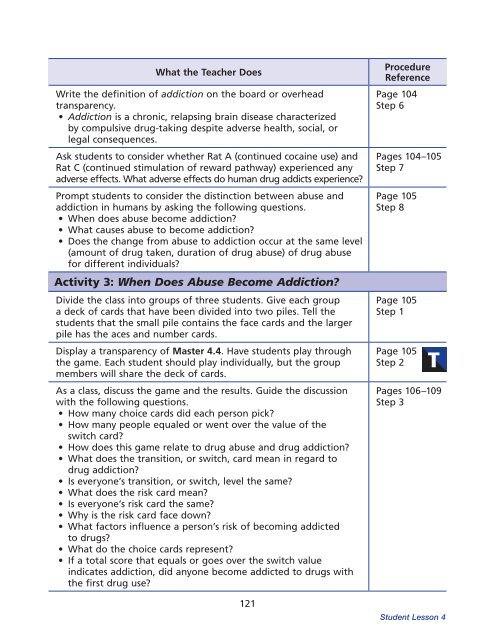Drug Abuse And Addiction - NIH Office of Science Education
Drug Abuse And Addiction - NIH Office of Science Education
Drug Abuse And Addiction - NIH Office of Science Education
Create successful ePaper yourself
Turn your PDF publications into a flip-book with our unique Google optimized e-Paper software.
What the Teacher DoesWrite the definition <strong>of</strong> addiction on the board or overheadtransparency.• <strong>Addiction</strong> is a chronic, relapsing brain disease characterizedby compulsive drug-taking despite adverse health, social, orlegal consequences.Ask students to consider whether Rat A (continued cocaine use) andRat C (continued stimulation <strong>of</strong> reward pathway) experienced anyadverse effects. What adverse effects do human drug addicts experience?Prompt students to consider the distinction between abuse andaddiction in humans by asking the following questions.• When does abuse become addiction?• What causes abuse to become addiction?• Does the change from abuse to addiction occur at the same level(amount <strong>of</strong> drug taken, duration <strong>of</strong> drug abuse) <strong>of</strong> drug abusefor different individuals?Activity 3: When Does <strong>Abuse</strong> Become <strong>Addiction</strong>?Divide the class into groups <strong>of</strong> three students. Give each groupa deck <strong>of</strong> cards that have been divided into two piles. Tell thestudents that the small pile contains the face cards and the largerpile has the aces and number cards.Display a transparency <strong>of</strong> Master 4.4. Have students play throughthe game. Each student should play individually, but the groupmembers will share the deck <strong>of</strong> cards.As a class, discuss the game and the results. Guide the discussionwith the following questions.• How many choice cards did each person pick?• How many people equaled or went over the value <strong>of</strong> theswitch card?• How does this game relate to drug abuse and drug addiction?• What does the transition, or switch, card mean in regard todrug addiction?• Is everyone’s transition, or switch, level the same?• What does the risk card mean?• Is everyone’s risk card the same?• Why is the risk card face down?• What factors influence a person’s risk <strong>of</strong> becoming addictedto drugs?• What do the choice cards represent?• If a total score that equals or goes over the switch valueindicates addiction, did anyone become addicted to drugs withthe first drug use?121ProcedureReferencePage 104Step 6Pages 104–105Step 7Page 105Step 8Page 105Step 1Page 105Step 2Pages 106–109Step 3Student Lesson 4
















